Deer trails are integral to what we do as hunters. We scout. We learn. We do our homework. Part of that homework consists of making sure we know and understand the network of trails that exist on the properties we hunt. Because if you don’t, you’re already at a disadvantage.
Deer hunting is a difficult endeavor. It isn’t easy. But one thing you can do to help make it easier is learn to read deer tracks and trails. Do that and scouting efforts will be that much easier. Below are the 10 tips to read deer trails rightly.
1. Determine Time of Use
It doesn’t matter how good you are at identifying and classifying trails if you can’t determine when they’re being used. Oftentimes, mature bucks will use two separate trails to enter and exit their bedding areas. Therefore, if you find a trail, usually (most of) the tracks will point in the same direction. If these tracks lead away from a bedding area, they’re being laid down of an afternoon. If they’re pointing toward a bedding area, they’re being made of a morning. The same concept generally applies to does and young bucks, too. Now that you know when a trail is being used, you can begin to determine its purpose.
2. Recognize Track Sizes
Being able to gauge the size and age of a deer based on its track is a true skill. It’s very beneficial to know this trade and it will help improve your scouting abilities. Those who learn it, often put it to use.
This trick is relative, but tracks that are less than 2 fingers wide are sub-adult deer. Those that are 2 to 3 fingers wide likely belong to adult does and younger bucks (yearlings to 2½-year-olds). Tracks that are nearly 4 fingers wide or wider belong to fully mature bucks.
3. Understand Track Orientation
Bucks have a small rear and a big chest. Therefore, buck back tracks are inside of their front tracks. Does have a little chest and big rear. Because of this, doe back tracks are outside of their front tracks. Furthermore, huge bucks have strides approximately a yard apart.
4. Decipher the Trail’s Purpose
As mentioned, different trails serve different purposes for deer. Trails that lead from thick cover to food sources are obviously used to reach the dinner table. Parallel trails that run along edges of fields and open areas are obviously used by bucks as they scent check for does. Trails that lead from bedding areas to bedding areas are predominately used by bucks as they travel in search of estrous does.
5. Set Up in Pinch-Points
It’s important to understand which trails have high odds of producing and which ones don’t. Any well-worn trails that lead through pinch-points are quality trails with a lot of potential. Setting up on the downwind side of these trails will offer a high probability of success, especially during the rut. On the contrary, trails in open timber without any change in terrain or topography have less potential.
6. Make Your Own Obstacles
One tip that I like to use on private land (where I have permission to do so) is to make my own barriers. Cutting down (unimportant) trees, piling brush and other things will help steer deer and they will ultimately create new trails where you want them to. It’s a very effective tactic.
7. Capitalize on Barriers
People often forget about what I call barriers. Barriers help to direct deer activity across the landscape. Anything that gets in a deer’s way is classified as such. Downed trees, rotting logs, large rocks, heavy brush, bodies of water, man-made structures and many more things can act as a barrier. Deer tend to travel around these, not through them. Because of this, anticipate how these obstacles will affect travel patterns and hunt accordingly.
8. Anticipate Activity Levels
You must be able to gauge how much a trail is used. If you’re meat hunting, find the trails with the most activity. The same goes for hunting big bucks during the rut, too. But outside of the rut, don’t overlook smaller trails with less activity. Mature bucks often use secondary trails that other deer don’t. Always look at these trails to see what size tracks are in them. This will tell you whether or not a mature buck is using it.

9. Chart the Trails
Something that I feel is very important is to chart deer trails on an aerial map. Print out a large map of the place you hunt. Then, walk every deer trail you can find. Draw a line on the aerial map for each trail. Color code primary, secondary, bed-to-feed, bed-to-water, and bed-to-bed trails differently so you can distinguish them and make good decisions on where to hunt regardless of the time of year. It’s also important to mark food and water sources, too. This will help you to better understand and visualize how deer use the land where you hunt. It’s an eye-opening practice. I promise.
10. Reevaluate Trail During the Post-Season
As previously mentioned, charting trails is a good idea. However, you need to reevaluate them after every season, see what’s changed, and amend your map(s). Deer behavior and how they use the land changes frequently.
